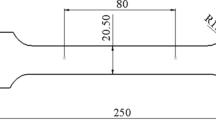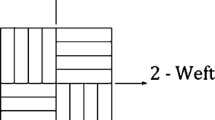Abstract
The micro-sandwich sheets with metallic/polymer fibrous core have been pointed out as one of the most promising technological solutions to the automotive industry. However, due to the lack of understanding of certain fundamentals related with the mechanical behavior of micro-sandwich sheets during forming processes, the transfer and scale-up of this promising technology to industry has been limited. A challenging aspect in the experimental characterization of these materials is related with the unknow properties of the composition of the core which consist of metallic (polymer) fibers and adhesive. In general, the suppliers of monolithic metal sheets also make available the respective datasheets with the mechanical and chemical properties. These datasheets use to refer the minimum, maximum or a specific tolerance range (dependent of the grade material) to the mechanical properties. However, the micro-sandwich sheets are not provided with this mechanical and chemical data, at least, for all layers. Therefore, it is missing a simple and robust methodology to supply the mechanical properties of the total micro-sandwich sheet to the industry. Furthermore, there is no study about the different numerical approaches available in the commercial stamping softwares to modelling and simulate micro-sandwich materials. In this work, a strategy to deduce the unknown mechanical properties of the fibrous core from symmetric or asymmetric micro-sandwich sheets, i.e., with the same or different skin thickness, is presented. For true stress-strain curves and anisotropy purposes, uniaxial tensile tests in 3 different directions, according ISO 6892-1:2009 standard, were performed. Total micro-sandwich specimens and skin specimens were tested. The mechanical properties of the core were deduced from micro-sandwich and skin’s mechanical properties. Based on this data, the constitutive model was established. Additionally, 6 different Nakazima geometries were punched according to ISO 12004 for formability assessment. Experimental Forming Limit Curves (FLC) and principal strains data were recorded during the tests thanks to a high-resolution cameras and software GOM ARAMIS. Finally, the experimental mechanical tests were virtually reproduced with both commercial codes AutoForm R5.2 and PAM-STAMP 2G 2015.1. Thus, different modelling strategies and Finite Element Method (FEM) approaches were compared. The excellent agreement between numerical and experimental results demonstrate the accuracy of the applied methodology.





























Similar content being viewed by others
References
Ghassemieh, E. (2011). “Materials in automotive application, state of the art and prospects, new trends and developments in automotive industry”, Prof. Marcello Chiaberge (Ed.), ISBN: 978–953–307-999-8, InTech, https://doi.org/10.5772/13286
Ermolaeva N, Castro M, Kandachar P (2004) Materials selection for an automotive structure by integrating structural optimization with environmental impact assessment. Mater Des 25(8):689–698. https://doi.org/10.1016/j.matdes.2004.02.021
Deshmukh AB, Chaitanya SV, Wagh S (2013) Case study on Sandwich steel application in automotive BIW for NVH improvements. IOSR Journal of Mechanical and Civil Engineering, 2nd National Conference on “Recent Developments in Mechanical Engineering” 1:1–6
Moreira RAS, Sousa RJA, Valente RAF (2010) A solid shell layerwise finite element for non-linear geometric and material analysis. Compos Struct 92(15):7–23
Chen L, Zhang Y (2013) A study on the application of material selection optimization approach for structural-acoustic optimization. Mater Des 52:207–213. https://doi.org/10.1016/j.matdes.2013.05.031
Wan H, Bai S, Li S, Mo J, Zhao S, Song Z (2013) Shielding performances of the designed hybrid laminates impacted by hypervelocity flyer. Mater Des 52:422–428. https://doi.org/10.1016/j.matdes.2013.05.050
Sinmazçelik T, Avcu E, Bora M, Çoban O (2011) A review: fibre metal laminates, background, bonding types and applied test methods. Materials & Design 32(7):3671–3685. https://doi.org/10.1016/j.matdes.2011.03.011
Palkowski H, Lange G (2005) Ame austenitic Sandwich materials in the focus of research. Metalurgija – Journal of Metallurgy 11:215–224
Besse, C. (2012) Development and Optimization of a Formable Sandwich Sheet. Materials and Structures in Mechanics [physics. class-ph]
Parsa MH, Ettehad M, Nasher S (2009) FLD determination of AL 3105/polypropylene/AL 3105 sandwich sheet using numerical calculation and experimental investigations. Int J Mater Form 2(1):407–410. https://doi.org/10.1007/s12289-009-0502-0
Kim KJ, Kim D, Choi SH, Chunga K, Shin KS, Barlat F, Oh KH, Youn JR (2003) Formability of AA5182/polypropylene/AA5182 Sandwich sheets. J Mater Process Technol 139(1-3):1–7. https://doi.org/10.1016/S0924-0136(03)00173-0
Sokolova OA, Kühn M, Palkowski H (2012) Deep drawing properties of lightweight steel/polymer/steel sandwich composites. Archives of Civil and Mechanical Engineering 12(2):105–112. https://doi.org/10.1016/j.acme.2012.05.001
Liu J, Xue W (2013) “Formability of AA5052/polyethylene/AA5052 sandwich sheets” Transactions of Nonferrous Metals Society of China. Vol 23(4):964–969. https://doi.org/10.1016/S1003-6326(13)62553-4
Logesh K, Raja VKB (2015) Formability analysis for enhancing forming parameters in AA8011/PP/AA1100 sandwich materials. Int J Adv Manuf Technol 93(1-4):1–8. https://doi.org/10.1007/s00170-015-7832-5
Mohammadi SV, Parsa NH, Aghchai AJ (2011) “Effect of the thickness distribution and setting condition on springback in multilayer sheet bending” International Journal of Engineering. Sci Technol 3(4):225–235. https://doi.org/10.4314/ijest.v3i4.68555
Crolla, D. (2015). Encyclopedia of automotive engineering. In: Palkowski, H. Sokolova, O.A. Carradó, A. “Materials and Manufacturing” - Sandwich Materials, pp.1–17. Online © 2014 Wiley https://doi.org/10.1002/9781118354179.auto163
Engel B, Buhl J (2012) Metal forming – process, tools, design. Chapter 4 “Forming of Sandwich Sheets Considering Changing Damping Properties”:85–108. https://doi.org/10.5772/50565
Mann D (1999) “Automotive plastics & composites - Worldwide Markets & Trends to 2007”, second ed. Elsevier, p 90
Carrado A, Faerber J, Niemeyer S, Ziegmann G, Palkowski H (2011) Metal/polymer/metal hybrid systems: towards potential formability applications. Compos Struct 93(2):715–721
TSE, 2014.https://www.thyssenkrupp-steel-europe.com/en/press/press-releases/press-release-6552.html
Xi Z, Zhu J, Tang H, Ao Q, Zhi H, Wang J, Li C (2011) “Progress of application researches of porous fiber metals” Materials. Vol. 4(4):816–824. https://doi.org/10.3390/ma4040816
R. Gustavsson, Formable Sandwich construction material and use of the material as construction material in vehicles, refrigerators, boats etc., patent WO a 9801295, 15 January 1998, AB Volvo, International
T.W. Clyne, A.E. Markaki, Ultra light stainless steel sheet material, US Patent 6764772, 20 July, 2004
Markaki, A.E.; Westgate, S.A.; Clyne, T.W. The stiffness and weldability of an ultra-light steel sandwich sheet material with a fibrous metal core. In Processing and Properties of Lightweight Cellular Metals and Structures; Ghosh, A., Sanders, T., Claar, D., EdZhou, D.W.; Stronge, W.J. Mechanical properities of fibrous core sandwich panels. Int. J. Mech. Sci. 2005, 47, 4–5. s.; TMS: Seattle, DC, USA, 2002; pp. 15–24
Tan JC, Westgate SA, Clyne TW (2007) Resistance welding of thin stainless steel Sandwich sheets with fibrous metallic cores: experimental and numerical studies. Sci Technol Weld Join 12(6):490–504. https://doi.org/10.1179/174329307X213666
Markaki AE, Clyne TW (2003) Mechanics of thin ultra-light stainless steel sandwich sheet material. Part I Acta Mater 51:1341–1350
Azeem MA, Shortall C, Ramamurty U (2007) Tensile properties of stainless steel sandwich sheets with fibrous cores. Scr Mater 57(3):221–224. https://doi.org/10.1016/j.scriptamat.2007.04.016
Cantor B, Grant P, Johnston C (2008) Automotive engineering: lightweight, functional, and novel materials. In: Chapter 14 “stainless steel Sandwich sheets with fibrous metals cores”. Taylor & Francis, New York
Engelmark M (2009) Usability evaluation of the fibrous Core Sandwich material Hybrix for automobile body applications. Master of Science Thesis Stockholm, Sweden, p 5,6
Jackson KP, Allwood JM, Landert M (2008) Incremental forming of sandwich panels. J Mater Process Technol 204(1-3):290–303
Mulone, A. (2015) “Characterization of ultra-light metal-polymer sandwich composite material through dynamic mechanical thermal analysis and microstructural analysis of nickel metal coating obtained through pulse-electrodeposition”, unpublished master’s thesis, Master of Science in Materials Engineering and Nanotechnology, Politecnico Di Milano - School of Industrial Engineering and Information, Italy
Starman B, Vrh M, Halilovič M, Štok B (2014) Advanced modelling of sheet metal forming considering anisotropy and Young’s Modulus evolution. Journal of Mechanical Engineering 60(2):84–92. https://doi.org/10.5545/sv-jme.2013.1349
Luzin V, Banovic S, Gnäupel-Herold T, Prask H, Ricker RE (2005) Measurement and calculation of elastic properties in low carbon steel sheet. Mater Sci Forum 495-497:1591–1596
Van Den Boscha, M.J. Schreursa, P.J.G. Geersa, M.G.D. (2009) “On the prediction of delamination during deep-drawing of polymer coated metal sheet”, J Mater Process Technol, vol. 209 pp. 297–302. doi: https://doi.org/10.1016/j.jmatprotec.2008.02.024, 1
Pauchard A (2009) Precise thin metal cutting using the laser MicroJet. Laser in der Elektronikproduktion & Feinwerkstechnik 15(2009):145–156
Car E, Oller S, Oñate E (2000) An anisotropic elastoplastic constitutive model for large strain analysis of fiber reinforced composite materials. Comput Methods Appl Mech Eng 185(2-4):245–277. https://doi.org/10.1016/S0045-7825(99)00262-5
Pupure, L. Joffe, Varna, R. Nyström, J. (2013) “Development of constitutive model for composites exhibiting time dependent properties”, IOP Conference Series: Materials Science and Engineering, vol. 48 012007
Swift HW (1952) Plastic instability under plane stress. Journal of the Mechanics and Physics of Solids 1(1):1–18. https://doi.org/10.1016/0022-5096(52)90002-1
Hill R (1998) The mathematical theory of plasticity. In: Oxford University press Inc. U.S.A, New York
Voce E (1948) The relationship between stress and strain for homogeneous deformations. J Inst Met 74:537–562
Pipard, J-M. Balan, T. Abed-Meraim, F. Lemoine, X. (2013) “Elasto-visco-plastic modeling of mild steels for sheet forming applications over a large range of strain rates”, International Journal of Solids and Structures, Vol. 50, issues 16-17, pp. 2691–2700
Kleemola HJ, Nieminen MA (1974) On the strain-hardening parameters of metals. Metall Trans A 5(1974):1863–1866
Neto DM, Oliveira MC, Alves JL, Menezes LF (2014) Influence of the plastic anisotropy modelling in the reverse deep drawing process simulation. Journal of Materials and Design 60:368–379. https://doi.org/10.1016/j.matdes.2014.04.008
Banabic, D. (2010). Sheet metal forming processes: Constitutive Modelling and Numerical Simulation, first Ed., Springer, ISBN: 978–3–540-88112-4, pp.45–52. https://doi.org/10.1007/978-3-540-88113-1
Slota J, Jurčišin M, Spišák E, Tomáš M, Šiser M (2015) Experimental determination of high strength steel sheet metal. Acta Metall Slovaca 21(4):269–277
EN ISO 12004-2:2008: Metallic materials, Sheet and strip, Determination of forming-limit curves, 2008
Pepelnjak T, Barisic B (2009) Computer-assisted engineering determination of the formability limit for thin sheet metals by a modified Marciniak method. J Strain Analysis 44(1):459–472. https://doi.org/10.1243/03093247JSA503
Tekkaya, E.A. Homberg, W. Brosius A. (2015). 60 excellent inventions in metal forming. In: Liewald, M. Schmid, P. Schneider, M. Papaioanu, A. “Short-cycle-stretch-forming (SCS)”, pp.95. © 2015 Springer Verlag - Berlin Heidelberg, Ltd. https://doi.org/10.1007/978-3-662-46312-3_15
Acknowledgments
The authors greatly acknowledge the financial support of “Fundação para a Ciência e Tecnologia” (FCT – Portugal), through the research project SFRH/BDE/51189/2010 (“Development FEA Tools Applied to Sheet Forming Special Cases. Application to the Automotive Industry, Advanced Metallic Materials and Multilayer and Multi-Material Sheets”) in partnership with Sodecia Product Competence Center (Maia, Portugal). The authors would also like to thank the company Lamera AB (Sweden), for providing the Hybrix material, ESI GROUP and AutoForm to the technical support and collaboration in this study.
Funding
This study was funded by SFRH/BDE/51189/2010.
Author information
Authors and Affiliations
Corresponding author
Ethics declarations
Conflict of interest
The authors declare that they have no conflict of interest.
Additional information
Publisher’s Note
Springer Nature remains neutral with regard to jurisdictional claims in published maps and institutional affiliations.
Rights and permissions
About this article
Cite this article
Pimentel, A.M.F., de Carvalho Martins Alves, J.L., de Seabra Merendeiro, N.M. et al. Modelling strategies and FEM approaches to characterize micro-sandwich sheets with unknown core properties. Int J Mater Form 12, 649–673 (2019). https://doi.org/10.1007/s12289-018-1441-4
Received:
Accepted:
Published:
Issue Date:
DOI: https://doi.org/10.1007/s12289-018-1441-4




